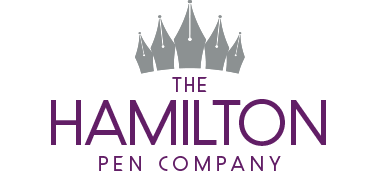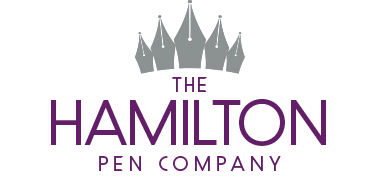One of the most common debates among pen collectors and enthusiasts is that of Gold nib vs Steel nib - which is best? It goes without saying that gold nib pens are more expensive than steel nibs but does this mean that they deliver a superior writing experience? How much does the material of a nib affect the quality of the pen? All of these questions are regularly asked across a number of platforms and The Hamilton Pen Company is here to jump in on the discussion!
Much like the salons of the 18th century Parisian thinkers, this debate is more about the joy of discussion. What we have found through our own experience and that of scholars, experts and devotees of the fountain pen is that there really isn't a consensus on which is best. The end….
Well not quite! Although it should be stated from the outset that we won't be changing the discourse and solving the debate once and for all, we will be exploring the unique characteristics of each nib type and discussing what makes for a great fountain pen nib. To set the scene of a discussion of the differences between gold and steel nibs, it makes sense to take a brief glimpse into the history of the fountain pen.

With thanks to The British Museum Romano British Split Nib Pen - On display: G49/dc2
A brief history of the fountain pen
One of the earliest forms of a ‘fountain pen’ was the Egyptian reed pen which was developed after the reed brush. Shaped from a piece of reed with a narrow point which was split to create a nib, ink would be poured through the hollow of the reed seeping to the nib - similar to a modern fountain pen. Two centuries later, feather quills began to emerge. This was in part a response to the limitations of the reed pen which produced a broad line which was ideal for the rough surface of papyrus, but the advent of parchment and vellum meant a finer line was warranted and adaptations for a smoother surface needed. Quills were often formed from goose feathers which, unlike its reed counterparts, could be sharpened to a finer point and was less prone to splitting.
According to James Ward;
‘The earliest specific reference to the quill comes from Saint Isidore of Seville in 624, who describes both the pinna (quill pen) and calamus (reed pen), showing that both continued to be used side by side…’
Feather Quills remained a popular writing tool until the nineteenth century where it became more common to find a metal nib. Interestingly, metal nibs had been around since the Romano-British era (AD 43-410) with the earliest surviving split-nib metal dip pen currently residing at the British Museum, made from a copper-alloy. These early metal nibs were rare due to the difficulty of producing a metal nib thin enough to produce a line that could compete with the quill.

Many consider the prototype of the modern fountain pen to have been created in the tenth century when Al-Mu'izz li-Din Allah commissioned a pen, Bosworth notes in his 1981 paper that in 953, al-Mu’izz ordered that a pen be created that would not stain his hands or clothes - a problem i'm sure many of us are familiar with! Drawing from the 1951 translation provided by Dr Hasan al-Basha Mahmud, it is said that Al-Mu’izz wrote;
‘We wish to construct a pen which can be used for writing without having recourse to an ink-holder and whose ink will be contained inside it. A person can fill it with ink and write whatever he likes. The writer can put it in his sleeve or anywhere he wishes and it will not stain nor will any drop of ink leak out of it. The ink will flow only when there is an intention to write. [Such a pen] will be a remarkable contrivance, [the like of] which we are unaware of anyone ever previously constructing, and an indication of 'penetrating wisdom’ to whoever contemplates it and realises its exact significance and purpose.’ pp232
It is said that the pen was created several days later and was crafted from gold - a precursor to our discussion perhaps? - and performed just as al-Mu’izz had hoped with the ability to be held any which way with no leakage.
There is however, no surviving evidence that such a pen was created beyond the reports of the time, however, there is compelling evidence that a working fountain pen was designed by Leonardo da Vinci in the 16th Century. In the codex atlanticus there are drawings dating to around 1508 which appear to represent cylindrical pens containing a reservoir of ink and a cap seal to prevent leaking. Da Vinci’s journals contain drawings outlining both gravity and capillary action reservoir pens. Even more interestingly, historians examining da Vinci’s journals state that the characteristic fading pattern of ink laid by a quill requiring re-dipping is not present and the consistent contrast in his handwriting would suggest that da Vinci had in fact constructed his pen design and utilised it through his work, again no physical pen survives but working models of the design have since been reconstructed.

In the 17th Century, German inventor Daniel Schwenter introduced a pen with an inner reservoir. Schwenters creation was formed from two quills, one inside the other, with the inner quill feeding the nib whilst remaining sealed with a cork at the other end. It was also during the 17th Century that Samuel Pepys made mention of a metal pen which carries ink and Hester Dorsey Richardson also wrote of pens which today we would describe as fountain pens. The early 17th Century features several reports of a long-writing pen with an ink reservoir, continuing through to the 18th Century but to misquote the playground chant...one, two, skip a few … on to the 19th Century!
Background of the modern nib:
The 19th Century is the crucial period for the development of the fountain pen as we know it. Birmingham was rapidly becoming the global capital of steel pen manufacture and in 1822, John Mitchell developed a system of mass-production for steel nibs which by the middle of the century led to Birmingham producing over half of all steel pen nibs worldwide.

This mass-production model meant that steel nib pens were produced relatively cheaply and yet they were renowned for being reliable meaning they were popular for use in schools. During this period, a golden era for pen patents began with designs, innovations and adaptations cropping up globally. Many of the initial designs for fountain pens were, although elegant in their own way, slightly problematic in terms of leaking, burping and time-consuming filling (eyedroppers were used to fill the ink well). It is often cited that the success of the future of fountain pens at this time was established by the invention of three things; hard rubber, iridium-tipped gold nibs and ink which was free flowing.
The latter required a better understanding of air pressure and the former was achieved thanks to the tinkering of the Goodyear (yes those Goodyear’s!) brothers who experimented with the chemistry of ebonite composites (ebonite being the brand name of hard rubber). Co-inventor of the first patented mechanical pencil, the ever-pointed pencil, John Isaac Hawkins succeeded in his mission to produce a hard fine point for fountain pens when he created the iridium pointed gold pen in 1834. Iridium was discovered with the platinum group of metals in 1803 (including ruthenium, and osmium), with Iridium being found to be the most corrosion-resistant metal so its use in fountain pen nibs was a logical application. The introduction of Iridium tipped nibs was a far better solution than the fragment of ruby that had been used in some early conceptions of the gold nib where hardwearing materials were needed for the wear-point to offset the softness of the gold (which maintained other benefits). But more on this shortly.

An iridium tip nib which has seen better days! showing no matter how hardy the materials - good pen care is essential!
It wasn't until the last two decades of the century that the first commercially successful fountain pen was introduced, aptly named the ‘ideal’ designed by Lewis Edson Waterman from New York, others had come before it, of course, but this was the beginning of a more reliable pen - less prone to leakage and with the added feature of fissures to the nib to drawn the ink down through a combination of gravity and capillary action. The advancements of pen design and innovation which took place during the 19th century meant that nibs had to be adjusted to reflect this and to ensure appropriate performance.

Gold nibs vs steel nibs
It was with the move away from dip pens to fountain pens that the debate between gold nibs vs steel nibs really began. In the days of dipping, nibs would be wiped down between uses to prevent rusting and discolouration. With the advancements of reservoir driven fountain pens where there is constant contact between the ink and the nib, corrosion of the steel nib became problematic.
It is for this reason that early fountain pens moved towards gold nibs, gold is a stable material and hold up well to the highly corrosive nature of iron-gall inks, of which ink was generally composed.
Modern fountain pen nibs are most commonly made of stainless steel or gold alloys with the most popular gold contents being 14karat and 18karat. Although titanium nibs are also emerging these are much less commonly found, even more rare is the exotic palladium nib associated with Visconti.

Cross Peerless 125 Nib Unit 18ct Gold
The debate around gold vs steel nibs has dramatically changed in the last 150 years as characteristics predominantly relating to corrosive resistant properties are far less of an issue due to the improvement of stainless steel alloys and far less corrosive inks.
Gold, titanium and most steel nibs are tipped with an alloy, normally including metals from the platinum group which act as a hard, wear resistant, corrosion resistant barrier. Although this was initially iridium, very few tipping alloys have contained iridium since the mid-1950’s - perhaps due to its low abundance on earth so until we start mining meteorites this is unlikely to change. Osmium, rhenium, ruthenium and tungsten are much more commonly found as alloys placed as tiny pellets attached to the nib tip prior to the formation of slits and the final grinding of the nib into shape.
As developments in the world of inks and the metals used in nibs have arisen, the price of fountain pens in general (although not exclusively) has become more affordable and greater ranges in price-point have become available meaning that even the smallest budget can afford a quality fountain pen. It may be argued that this has improved the overall quality of fountain pens due to global competition - but that’s a discussion for another day.
Why are gold nibs considered more desirable?
There does seem to be a leaning toward gold nibs across discussions of better nib types, why is this? One response may be that it is a purist approach based on the earliest versions of fountain pens presenting with gold nibs, although this reason does not necessarily hold traction with the advancements in steel alloys that we have discussed.
One argument turns to the properties of gold for an answer. Gold plating provides favourable wettability, this refers to the interaction between solids and liquids and thusly the ability of gold to reduce the surface tension of the ink allowing for a smoother spread across the surface.
Another property of gold well suited to its use as a fountain pen nib is its classification as a noble metal (in many ways!) meaning it is highly resistant to corrosion and oxidation plus it is resistant to most acids (most inks are on the more acidic side...again a growing prominence of ‘ph neutral’ inks is a discussion for another time). The malleability of gold - it is in fact the most malleable metal - provides a pliable feel and more bounce and flex during use as opposed to steel which is more commonly stiffer. The flexibility of a gold nib suggests a wider range of line variance and some consider this pliability as permitting for greater character in the writing process. A gold nib adjusts to the handwriting style of the user as the malleable nature means it softens and misshapes imperceptibly over time though the extent to which this is true in lower karat nibs is unclear.

S.T. Dupont Line D Fountain Pen Atelier Blue Lacquer 14ct Gold nib
In the same way that advancements in the way gold has been utilised has led to improvements for gold nibbed pens, the advancements the use of stainless steel and alloys has also driven the way steel nibbed fountain pens are received. The benefit of the softness of gold is well documented and as such, nib manufacturers have adapted some of this through the way that steel nibs are crafted so as to allow for more flex and a smooth writing experience. Furthermore, the experience of writing with a fountain pen is one of personal style and taste so for many people, a harder or scratchier experience may be the preference.

Onoto Aviator Fountain Pen, Sterling Silver, 18ct Gold nib
The key to the writing experience is determined by the user in many aspects but removing personal preference, it is how well the tip flows across the paper which is more resolute in defining a good vs bad pen.
Given that the leading concerns regarding fountain pens which determined the better nib materials have all but been resolved, its seems that the debate surrounding gold vs steel nib preference can be reduced to a discussion of quality.
Yes there will be characteristics of each nib type which speak more closely to certain people but ultimately, so long as the manufacturing process and quality of the material is well considered and executed there should be little in the margins to debate.

Platignum Studio Fountain Pen Stainless Steel nib
There is a very large and very loud elephant in the room which should be addressed. The preference for gold nibs may well be ...dare I say...down to prestige and presentation!
Whilst we all recover from that taboo comment (how can we be so audacious as to suggest such a thing!) let me elaborate. A fountain pen is at its foundations a writing tool, it is a piece of technology designed to serve a purpose. But, a fountain pen is also so much more than that. A fountain pen can be a slice of luxury, it can be a way to connect with a more analogue world, it can be a statement or a work of art. It can be many things.
A gold nib is a further aesthetic delight which elevates a pen beyond the realms of being just a pen. The value of gold is relatively constant so fountain pens with gold nibs, and especially those with additional precious elements, can be a wonderful investment and a delightful heirloom.

Montegrappa Ernest Hemmingway Limited Edition Fountain Pen 'The Writer' 18ct Gold
If you are still with me at this point you will likely be someone who already appreciates the magic of a beautiful pen; whether gold nibbed, steel nibbed, or your favourite budget offering that happens to have the perfect page feel for you. Ultimately a gold nib or a steel nib can provide the perfect writing experience (or titanium or palladium to that point!) but it’s the craftsmanship, design, ergonomics, ink, nib type or any number of factors combined - working in harmony - that creates the best writing experience and for many it comes down to personal preference.
Sources:
Ward, J. 2014. The Perfection of the Paperclip: Curious tales of invention, accidental genius, and stationery obsession. Touchstone: New York. pp.28.
C.E. Bosworth, A Mediaeval Islamic Prototype of the Fountain Pen?, Journal of Semitic Studies, Volume 26, Issue 2, AUTUMN 1981, Pages 229–234




